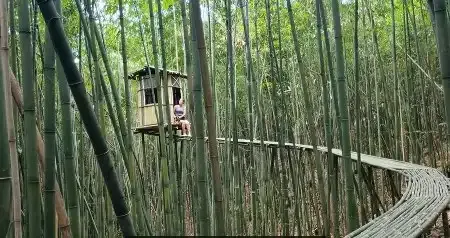Bamboo textile
Bamboo textile, also known as bamboo fabric or fiber, is a versatile and sustainable material that has recently gained significant popularity. It is made from the pulp of bamboo plants, which have been cultivated for centuries in various parts of the world.
The production process of bamboo textiles begins with harvesting mature bamboo stalks. These stalks are then crushed to extract the cellulose fibers within. The extracted fibers undergo hydrolysis alkalization, broken down into a viscous substance called "bamboo cellulose." This substance is then spun into threads through either mechanical or chemical methods.
One notable benefit of utilizing bamboo textiles is their eco-friendliness. Bamboo plants are renowned for their fast growth rate and minimal need for pesticides or fertilizers. They can reach maturity within three to five years compared to decades for traditional timber trees like oak or pine. Additionally, the bamboo fabric does not require extensive chemical treatments during manufacturing due to its natural antibacterial properties.
Furthermore, bamboo textiles have several advantages over conventional fabrics such as cotton or polyester. Firstly, it possesses excellent moisture-wicking capabilities by absorbing sweat and allowing it to evaporate quickly—making it ideal for sportswear or activewear applications. Secondly, bamboo fabric has inherent temperature-regulating properties that keep individuals relaxed during hot weather conditions while providing warmth during colder climates.
Characteristics of Bamboo textile
i. One of the most notable benefits of bamboo textiles is their sustainability. Bamboo is known to be one of the fastest-growing plants on Earth, capable of reaching maturity in just a few years compared to traditional hardwood trees, which can take several decades. This rapid growth makes it highly renewable and reduces pressure on forest resources. Moreover, bamboo requires minimal water usage and does not rely heavily on pesticides or fertilizers for its cultivation.
ii. It also exhibits excellent antibacterial properties naturally found within the plant called "bamboo kun." These antimicrobial characteristics inhibit bacteria's ability to thrive on fabric surfaces without requiring additional treatments with potentially harmful substances such as triclosan, often used in other antibacterial fabrics.
iii. Additionally, bamboo fibers have a luxurious feel similar to silk while being more affordable than genuine silk products. The smooth texture of bamboo textiles makes them pleasant to the touch, offering a comfortable and soft sensation against the skin.
iv. It also exhibits impressive durability and breathability traits—rendering it highly suitable for everyday clothing items like shirts and dresses. Moreover, these textiles possess a soft texture similar to silk but at a significantly lower cost—an economically and ethically appealing aspect.
Bamboo textile manufacturers
Bamboo textile manufacturers play a significant role in the global textile industry by providing sustainable and eco-friendly alternatives to traditional fabrics. As concerns about climate change and environmental degradation continue to grow, consumers are increasingly seeking products that have minimal impact on the planet. Bamboo textiles have emerged as a solution, offering several advantages over conventional materials.
Firstly, bamboo is a highly renewable resource with remarkable growth characteristics. It is known for its rapid growth rate, reaching maturity within three to five years compared to trees which can take decades. This fast growth enables bamboo forests to be replenished quickly, reducing deforestation pressures and preserving natural habitats.
Furthermore, bamboo requires no pesticides or fertilizers for cultivation as it possesses natural antibacterial properties that protect it from pests and diseases. This makes bamboo farming environmentally friendly, eliminating harmful chemical usage associated with other crops used in textile production.
The manufacturing process of bamboo textiles also contributes significantly to their sustainability. After harvesting mature bamboo stalks (culms), they undergo a series of mechanical functions, such as crushing and retting, before being transformed into fibers through mechanical or chemical methods. Automatic processing involves crushing the culms mechanically, followed by a combing process that separates fibers from non-fibrous components like lignin. Chemical processing utilizes enzymes or chemicals like sodium hydroxide to break down the cellulose structure in culms into individual fibers.
Once transformed into fibers, these can be spun into yarns using techniques depending on desired fabric properties such as softness or durability. These yarns are then woven or knitted into different fabrics suitable for diverse applications, including clothing, bedding, towels, and more.
From a sustainability standpoint, bamboo textile production requires less water than conventional cotton farming while yielding higher fiber output per unit area. Additionally, due to its natural antibacterial properties mentioned earlier in the cultivation phases (which continue in finished products), it helps reduce bacterial growth on clothing items, reducing washing frequency and saving water during the garment care process.
Furthermore, unlike other plant-based textile options like cotton or linen, which require harsh chemical treatments during production (such as bleaching or dyeing processes), bamboo fabrics retain their natural coloration capabilities throughout processing stages, thus sparing the environment from unnecessary pollution through toxic chemicals disposal into the water streams, etc.,
The rise of bamboo textile manufacturers signifies a positive shift towards sustainable practices within the textile industry. With its eco-friendly cultivation methods and numerous inherent qualities, including moisture-wicking abilities, anti-odor properties, and softness and breathability, among others - bamboo has become increasingly valued by consumers seeking responsible alternatives to traditional textiles from non-renewable resources like petroleum-derived synthetics.
Bamboo textile products
Bamboo textile products have gained significant attention recently due to their numerous advantages and sustainable characteristics. Derived from the fast-growing bamboo plant, these textiles offer various applications across various industries, including fashion, home furnishings, and even technical textiles. Bamboo textile products have emerged as a promising solution in light of increasing environmental concerns and the need for more eco-friendly alternatives.
Furthermore, bamboo textiles possess remarkable properties that make them advantageous over conventional fabrics such as cotton or polyester. One key attribute is their exceptional breathability; they allow air circulation, which helps regulate body temperature and wick away moisture efficiently - ideal for activewear garments or bedding items where comfort is crucial.
While there are numerous advantages to bamboo textile products, it is also essential to consider some potential limitations. While mechanical processing is primarily used, chemical methods can still be employed in some instances to convert bamboo into fibers or treat fabrics for specific properties. Ensuring that environmentally friendly manufacturing practices are adopted throughout the production cycle is crucial.
Furthermore, like any other textile product, proper care and maintenance are necessary to extend their lifespan and retain their desirable qualities. Following manufacturer instructions regarding washing techniques and avoiding harsh detergents or bleach will help maintain the longevity of bamboo textiles.
Environmental Impacts of Bamboo Textiles
Bamboo textiles provide exceptional comfort and contribute significantly toward mitigating environmental impacts associated with traditional fabric manufacturing processes. As more customers prioritize sustainability when purchasing decisions, manufacturers have a vital role in fulfilling these demands by producing high-quality, eco-friendly bamboo textiles that appeal to the conscientious consumer.
The production process for turning bamboo into textile fibers enhances its environmentally friendly qualities. The majority of bamboo fabric production involves mechanical rather than chemical processes. Mechanical methods crush the woody parts of the plant before natural enzymes break down the pulp into fine fibers, which are then spun into yarns for weaving or knitting fabrics. Bamboo textiles have significantly lower environmental impacts compared to other synthetic materials like polyester or nylon that require energy-intensive processes involving harmful chemicals.
Advantages of bamboo textiles
i. One of the critical advantages of bamboo textiles is their exceptional comfort and breathability due to their unique fiber structure. Bamboo fibers contain microscopic gaps allowing enhanced moisture absorption and ventilation compared to synthetic counterparts like polyester or nylon. This superior moisture-wicking ability keeps individuals cool in hot weather and helps regulate body temperature, making bamboo textiles a popular choice for activewear and bedding.
ii. Additionally, bamboo fabrics offer natural anti-odor properties owing to the presence of a bio-agent called "bamboo kun." This substance inhibits the growth of bacteria on the fabric's surface, reducing unpleasant odors even after extended use. Such features make bamboo textiles highly desirable for sportswear or undergarments where odor control is crucial.
iii. Moreover, bamboo textiles are renowned for their softness and luxurious feel. The fibers' smooth texture makes them gentle against the skin, minimizing irritation and allergies caused by rougher materials such as wool or synthetic fibers. Bamboo fabrics also have excellent drape and elasticity, allowing for comfortable movement and easy wear.
Disadvantages of bamboo textiles
i. However beneficial it may be, some concerns associated with the production of bamboo textiles also deserve attention. One problem revolves around the chemicals used in specific manufacturing processes, such as hydrolysis alkalization. While efforts are being made to develop greener alternatives, some chemical solutions used in the production of bamboo cellulose may have negative environmental impacts if not properly managed.
ii. Another consideration is that although bamboo plants are sustainable, transforming from plant to textile involves energy-intensive processes such as pulping and spinning. These processes can offset some of the eco-friendly aspects of growing bamboo.
iii. Nevertheless, ongoing research and development within the industry continue to address these concerns and seek more sustainable production methods for bamboo textiles.
Conclusion
Bamboo textile offers a promising alternative to conventional fabrics due to its sustainability credentials and various desirable qualities. As consumers become increasingly conscious of their environmental impact, choosing materials such as bamboo fabric can contribute positively towards a more environmentally friendly fashion industry. With further technological advancements and increased awareness surrounding responsible manufacturing practices, we will likely witness continued growth and innovation in bamboo textile production.
Bamboo textile products have emerged as a sustainable alternative within various industries, marked by their eco-friendly characteristics, impressive breathability, natural antibacterial properties, and affordability compared to silk alternatives while providing a luxurious feel against the skin. As consumer demand for more environmentally conscious choices overgrows, embracing bamboo textiles presents economic opportunities and positive environmental impact in promoting sustainability across different sectors.












0 Comments